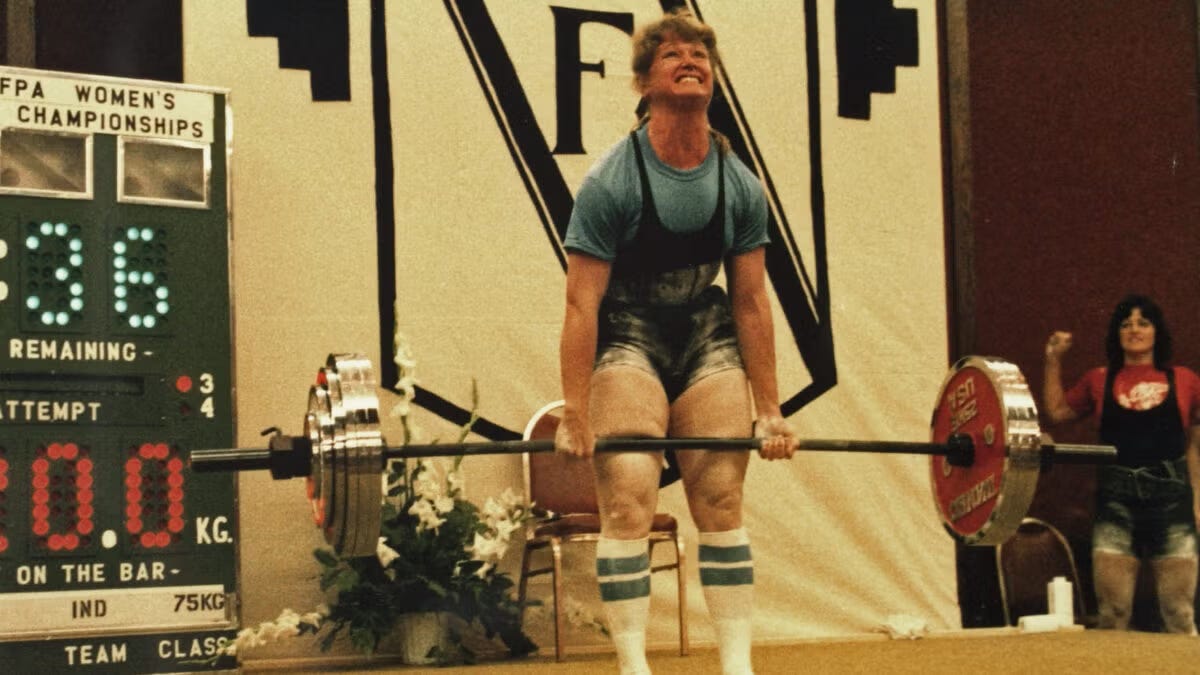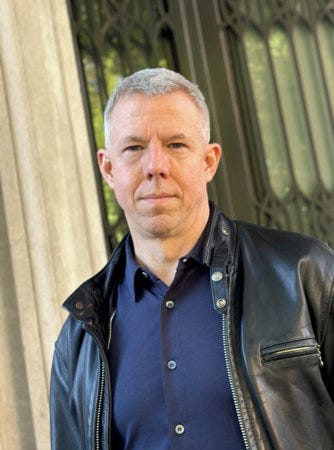Finding Lost Voices: Getting to Know the Strongest Woman in the World, Jan Todd through Michael Joseph Gross's book Stronger
A weekly email that brings back the voices of those who have been forgotten or misremembered
Last year, I worked as a coach at a local gym. Whenever new women joined the gym and saw my strong shoulders, many would say, "I don’t want to get big; I just want to get toned."
Comments like that always amazed me. First of all, building significant muscle mass takes a considerable amount of time and a lot of hard work. And second, why not? Why wouldn’t you want to be strong, or even look strong?
Why does American culture make women feel that having a powerful, muscular body is something abnormal or undesirable?
Recently, I sat down with author Michael Joseph Gross to discuss his new book, Stronger: The Untold Story of Muscle in Our Lives. As we talked, I kept thinking about those questions. Gross explores our complex relationship with muscle through the stories of three individuals whose careers deepened our understanding about muscle: sports historian and College of Education Associate Professor of Kinesiology At University of Texas at Austin, Charles Stocking, exercise physiologist and geriatrician Maria Fiatarone Singh of the University of Sydney and the Stark Center for Physical Culture and Sports at the University of Texas at Austin Founder and Director Jan Todd.
What drew me to Gross’s book was how he portrayed the life of Jan Todd and her experiences as a strong-bodied woman in America. In addition to running the Stark Center, Todd currently serves as the chair of the Department of Kinesiology and Health Education at the University of Texas at Austin. At the height of her athletic career, Sports Illustrated called her “the strongest woman in the world,” and she held entries in the Guinness Book of World Records for over a decade. Beyond her achievements in strength sports, Todd is also a leading scholar in exercise science, so who better to help us understand what it’s like to grow up in a society that often fails to value strong-bodied women?
In 1973, Todd and her husband, Terry Todd, the 1964 U.S. national powerlifting champion, were visiting his parents in Austin, Texas. One afternoon, Jan decided to join Terry at the Texas Athletic Club. At the time, it was rare for women to train in the same gyms as men. Most gyms either excluded women entirely or designated separate days for each gender.
That day, Jan hadn’t intended to lift much. But there was another woman at the gym—a petite lifter pulling heavy deadlifts. She weighed just 115 pounds, but had 225 pounds on the bar. As Michael Joseph Gross describes in Stronger, when Todd saw that woman pulling so much weight, she was captivated. “Todd watched the woman’s every move,” and “watching these movements changed Jan Todd’s life.”
Todd had grown up in a culture where femininity and physical strength were seen as opposites. As Todd told Gross, “‘girls didn’t try hard, and girls didn’t do sport,’ she was astonished to see a woman exert great force by means of muscle.”
Something shifted for Todd that day. Perhaps it was simply the sight of another woman doing it. She let go of her inhibitions, walked up to the bar, and lifted it herself.
She was a natural.
Eighteen months and a lot of intense training later, on May 5, 1975, at the Central YMCA in Chattanooga, Jan Todd broke the Guinness World Record for the heaviest deadlift by a woman when she deadlifted 394.5 pounds.
“Breaking the record opened a new world for me,” Todd later said, “because I realized that almost all of the fears we have and the barriers we set for ourselves as women are in our minds.” And how did those barriers get into our minds? Undoubtedly, through our culture, a culture that continues to stress that being a woman and being strong-bodied are not compatible.
As Gross underscores, Todd “has helped to establish historical and scientific proof that muscular strength and access to knowledge about strength training are important aspects of social equality and opportunity for women.”
It was Terry who first introduced Jan to the woman who would become her hero: Katie Sandwina, also known as Katharina Brumbach (you can read my earlier post about Sandwina here). Sandwina was a foremother, an early strongwoman who performed on the Vaudeville circuit and later with Barnum and Bailey’s Circus in the early 1900s. Standing 5 feet 10 inches tall and weighing 210 pounds, she normalized the idea of being a strong-bodied woman lifting weights decades before it was culturally accepted.
In Stronger, Gross highlights how, in a culture that doesn’t value physical strength in women, it’s vital for women to have role models. He suggests that if that one woman hadn’t been lifting at the gym the day Todd visited, she might never have picked up a barbell or gone on to become a world champion. And if she hadn’t learned about previous women who had lifted weights like Katie Sandwina, she might not have kept going on her path towards becoming the strongest woman in the world.
Gross also explores Todd’s experience growing up in a body that felt out of place. As a child, she felt her strong, muscular frame was an anomaly among her peers. She recalls, “The main thing I remember about growing up is that I always felt like I had a weight problem… like a larger species of the same animal.” Todd’s father discouraged her from taking up ballet, fearing her calves would become too muscular. So she turned to one of the few sports available to girls at the time: swimming.
By the time she achieved her world record, Todd stood 5 feet 7 inches tall and weighed 165 pounds. As she continued to train and build muscle, those around her began offering unsolicited warnings. Some said she would ruin her figure. Others went so far as to claim that lifting weights could cause her uterus to fall out. But, luckily, Todd didn’t listen, and she went on to change the world of powerlifting.
It’s Gross’s careful attention to how the story of muscle intersects with the lives of women that makes Stronger such a powerful and necessary book.
What follows is my conversation with Michael Joseph Gross about Stronger:
Iris Jamahl Dunkle: One of the things I loved most about your book was how, in the male-dominated story about muscle, you focused on women. Why did you take this approach?
Michael Joseph Gross: There are two things that come to mind. First, I knew I wanted to build the book around the stories of three people. One would be a doctor, and another a historian. It just so happened that the preeminent strength training researcher is a woman, and the leading historian of physical culture is also a woman. So the world made that decision for me. And I love that they were women, exactly for the reason you mentioned. The story of strength and muscle has mostly been told as a story about men, leaving out half of humanity. It seemed only right that this book should shift that balance. We've got a lot of making up to do.
Dunkle: Can you tell me a little about meeting Jan Todd?
Gross: When I was writing the proposal for the book, I found a goldmine: Iron Game History. Jan's writing stood out for its rigor and curiosity. I sent her a cold email, and she called me right back while I was walking down a busy street in New York. She said, "So you’ve got some questions for me?" I asked a couple, not very impressively, and she let me know.
Later, I read a book review she wrote where she completely dismantled another author's work for not reading foundational texts. I ordered every book she cited in that review and put myself on a reading diet until I felt ready to reach out again. Eventually, I got to meet her and Terry in person in 2016. At our first lunch, I told them I wanted to write about Jan in a way that did justice to her depth and impact. They were hesitant, but by the end of the weekend, they agreed.
They let me interview colleagues and friends, shared archival materials, and supported turning this book into a hybrid of biography, history, and journalism.
Dunkle: I love how you began the book with The Great Sandwina.
Gross: I went to the Billy Rose Library in New York to follow Jan’s research trail on Sandwina and spent dozens of hours combing through old newspaper archives. Jan often talks about how poorly we honor our exemplars of strength once their powers fade. Sandwina is a poignant example of that.
Dunkle: You address the cultural resistance women face when developing muscle. That deeply resonated with me as a strong-bodied woman and former swimmer. I’ve heard the same things Jan did—"you’ll look like a man," "don’t bulk up." Even now, my clients often come in saying, "I just want to tone." That stigma hasn’t gone away.
Gross: We need to hear the voices of strong-bodied women athletes today. That’s why I was drawn to social science research like Molly George’s paper Making Sense of Muscle. It captures the ambivalence many women feel about their bodies. I faced pushback from early readers who didn’t want to believe this ambivalence still exists.
Dunkle: That’s so real. As a female writer, I often feel I’m not seen as a credible voice about my own experience. Editors sometimes say, "That’s not relevant anymore." But it is.
Gross: Exactly. Part of what I wanted to do with this book was normalize women’s experiences with strength. Let them speak for themselves. Jan is on equal footing with the other voices in the book. Her story about walking into a gym and seeing another woman deadlifting—that’s powerful. It changed her life. She had a foremother, and now through this book, she becomes one.
Dunkle: And you highlight her perseverance, not just her genetic gifts. She trained harder than Terry and worked tirelessly to change perceptions about strong women.
Gross: That means so much to hear. Jan could’ve gone down a different path. But she didn’t, and the world is better for it. Our physical experiences depend as much on our social environment as on our bodies.
Dunkle: What drew you to this subject?
Gross: I was writing long investigative pieces at Vanity Fair, mostly about tech and national security. It was stressful. I wanted to reconnect with my body, so I took up whitewater kayaking. I realized I needed to get stronger and started lifting weights seriously.
What began as training for kayaking became a deep curiosity about strength itself. I looked for a book that connected the science, history, language, gender politics, and even the art of muscle—but couldn’t find one. That’s when I decided to write it.
I wanted this book to speak to everyone: elite CrossFitters, older adults recovering from injury, doctors, and people who’ve never lifted a weight. Strength training is one of the most accessible and beneficial forms of exercise, and yet so few people understand it. I wanted to create a shared vocabulary, a common space for everyone to explore what it means to be strong.
Dunkle: Thank you so much for this wonderful conversation!
For More Information
Read Stronger: The Untold Story of Muscle in Our Lives By Michael Joseph Gross
Visit The Stark Center to learn more about the history of Physical Culture
Listen to this “Powerlifting pioneer Jan Todd recalls her barrier-breaking deadlift record 50 years later”







Yes, way back when I was a teenager in the l950s my mother told me that men did not like women who could beat them at tennis -- and so I stopped playing, of course...
🔥🔥🔥